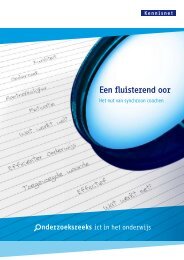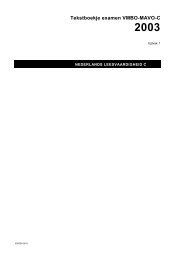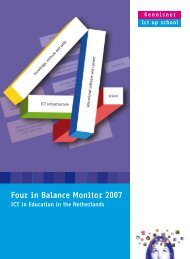Four in Balance Monitor 2011 - downloads.kennisn... - Kennisnet
Four in Balance Monitor 2011 - downloads.kennisn... - Kennisnet
Four in Balance Monitor 2011 - downloads.kennisn... - Kennisnet
Create successful ePaper yourself
Turn your PDF publications into a flip-book with our unique Google optimized e-Paper software.
2 - BENEFITS oF USING ICT<br />
A good example of asynchronous e-learn<strong>in</strong>g is the Khan Academy<br />
(www.khanacademy.org/), which has more than 2000 <strong>in</strong>structional videos<br />
that pupils can watch whenever it suits them.<br />
A more radical form of e-learn<strong>in</strong>g is the digital tutor, an overall<br />
<strong>in</strong>struction program that pupils can work through with m<strong>in</strong>imal teacher<br />
<strong>in</strong>tervention. It is particularly popular <strong>in</strong> higher education (for example<br />
the open University of the Netherlands), but primary schools are also<br />
experiment<strong>in</strong>g with it. For example, some Dutch primary schools used a<br />
digital tutor for their English lessons (hovius, 2010). The tutors guided the<br />
pupils through a series of topics <strong>in</strong> English on the <strong>in</strong>teractive whiteboard,<br />
address<strong>in</strong>g them <strong>in</strong> native-speaker-quality English. The pupils also<br />
watched films and carried out assignments. The pupils who had received<br />
lessons from the digital tutor were just as motivated and performed just as<br />
well as the control group pupils who had been <strong>in</strong>structed by a teacher <strong>in</strong><br />
the traditional manner.<br />
There is little evidence that such e-learn<strong>in</strong>g methods actually improve<br />
teach<strong>in</strong>g and learn<strong>in</strong>g, however (Lemke, 2009). What is certa<strong>in</strong> is that they<br />
require teachers to have outstand<strong>in</strong>g skills, for example so that they can<br />
ma<strong>in</strong>ta<strong>in</strong> order <strong>in</strong> onl<strong>in</strong>e classes, check whether pupils understand the<br />
material, and relate the digital material to the regular material.<br />
2.4 Structured practice<br />
The po<strong>in</strong>t of knowledge transfer is to give pupils a solid knowledge base.<br />
Knowledge transfer <strong>in</strong>volves convey<strong>in</strong>g new knowledge to pupils (Section<br />
2.3), but it is also vital for that knowledge to “stick” and for pupils to be<br />
able to recall it immediately. The most suitable learn<strong>in</strong>g activity for this<br />
is practice (mak<strong>in</strong>g knowledge automatic). We def<strong>in</strong>e practic<strong>in</strong>g broadly<br />
to mean the rote memorization of facts (such as words), the application of<br />
learned rules (such as grammar rules) and skills exercises (such as learn<strong>in</strong>g<br />
to touch type).<br />
Positive results have been achieved with practice software, subject to the<br />
right conditions. A well-designed program should allow pupils to practice<br />
21








